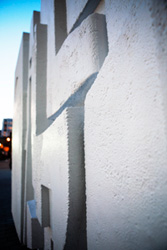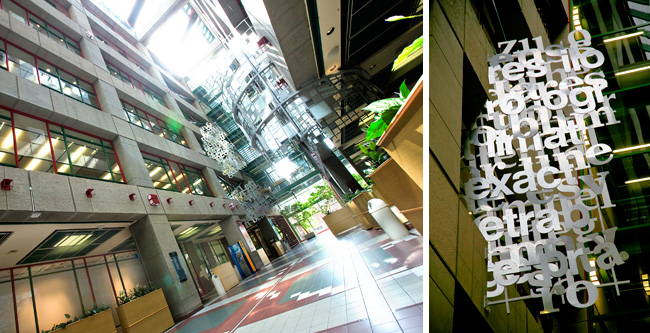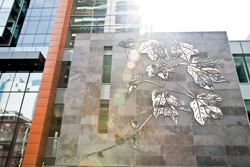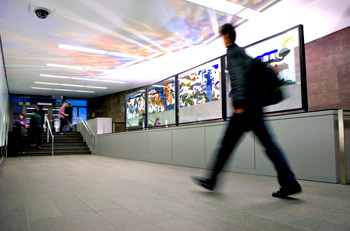Concordia's treasure hunt

Concordia’s Faculty of Fine Arts is recognized as one of the most prestigious art schools in the country. Appropriately, art works are prominently displayed through many university buildings on both the Sir George Williams and Loyola campuses.
Clarence Epstein, Concordia’s director of Special Projects and Cultural Affairs in the Office of the President, asserts that art is inseparable from the intellectual life at Concordia, an institution that stands out ?for its innovation.
Epstein has been working at the university since 2000 to identify its cultural property, which in some cases was left untended. That included nearly 200 artefacts scattered throughout offices, corridors, hallways and even nameless storage sites.
During the 1960s and 1970s, the government was the university’s main patron. Beyond the public art integrated into the buildings, university administrators encouraged the purchase of furniture and objets d’art to improve certain public spaces. “Art was not just for galleries but radiated in the public arena,” Epstein says.
Public art and its contextual anchor
Epstein emphasizes that before the creation of Concordia University in 1974, Sir George Williams University and Loyola College had not put in place a monitoring system for the conservation and development of public art.
“At the time of ?the merger, art collections were not seen as key,” Epstein says.

Besides the works commissioned by the university, some private real estate developers also did their part to enhance public spaces.
One such example is Claude Théberge’s distinctive mural on the east side of the Guy Metro (GM) Building. (The artist distinguished himself in the 1960s by organizing a workshop specializing in art integrated into architecture.
Théberge designed his works according to where they would ?be installed.) After Concordia bought the GM Building, its administrators discovered no records about Théberge. Epstein had to search for the documentation and development of the unique piece.

Throughout the university’s properties, Epstein and ?his team have found an unexpected richness in the diverse ?collection of works commissioned over four decades. “?Apart from a few gifts by corporate donators or benefactors, the university did not yet have a real policy of acquisition,” he says of the earlier days. “Not until the early 1990s did that change.”
The construction of the John W. McConnell Library Building in 1992 kicked off the new era. Several new works were incorporated into the building through the Quebec 1% policy [the provincial government policy that states 1% of the budget for new public buildings must be spent on public art]. “That was done by a team led by artist Rose-Marie Goulet, who won the competition,” Epstein explains.
Goulet and a team of urban design specialists incorporated a metal spiral to depict texts, matching the library’s rich linguistic tradition.
The resulting work, called An Explosion of Letters, appears on the front of the Library Building and again in the lobby, over a stairwell and inside a reading room.

Test of time
Concordia’s head of cultural affairs adds that this type of work is distinguished by its permanent visibility in the public domain.

“It also stands out because of the quality of materials, which will help to put it through the test of time,” Epstein says. “Because of the weather or acts of vandalism that may damage the work, its sustainability is essential.”
This latter consideration undoubtedly guided Geneviève Cadieux’s design of the huge mural on the main facade of the John Molson School of Business Building.
The monumental work, called Lierre sur Pierre (Ivy on Stone), includes massive sheets of ivy made of anodized steel attached to a 150-square-metre limestone wall.
The reflective surface of ivy leaves catches the attention of passers-by and seems to mirror the university’s willingness to engage the Montreal community.
A common destiny
Epstein explains that Concordia and the City of Montreal share the goal of bringing art to the public, which has led to countless cultural exchanges over the years. “The university is trying to project the message and showcase that art provides a bridge between education and culture,” he says.
This back-and-forth between culture and society is central to the theme of a new public art work to be displayed on the Loyola Campus. The work by Adad Hannah, MFA 04 (now a Concordia PhD student), called LEAP, will adorn the large front window of the PERFORM Centre, set to open at Loyola in 2011.
The window is covered with photographs that were baked onto a glass surface. Inspired by the motion studies of Eadweard Muybridge’s famous works, LEAP evokes the human body in motion and its many transformations over time. “The artist used models who come from all walks of life, of all ages and all genres,” Epstein states. “This is a reflection of the Concordia community in its very essence. And it is timely because it comes near the end of the Montreal City of Glass activities.”

Montreal City of Glass
In 2010, Concordia participated in Montreal City of Glass, a series of exhibitions and events sponsored by the Board of Montreal Museum Directors (BMMD). It showcased a variety of local glass works featured in architecture and public art. The works were displayed at several Montreal museums, Metro stations and public institutions.
Manon Blanchette, CEO of the BMMD, says Concordia has made an outstanding contribution in integrating glass in its public works of art. “The vast canopy by Nicolas Baier—on the east side of Concordia’s Engineering, Computer Science and Visual Arts Integrated Complex [EV Building]—has literally transformed the entire area,” Blanchette says. “When you go there, you can look up and see the movement of the leaves that seem to shift under the changing light.”
Glass plays an important role for allowing in light in northern countries, where the sun is less present during the cold season. Yehouda Chaki, a Mediterranean-born local artist who liberally uses colour in his paintings, says that light provides a continuous source of inspiration for him.

“An artist’s role is to adapt to ambient light because our inspiration springs from what I call a spiritual light. This makes all the difference in the end,” Chaki says.
Concordia entrusted Chaki with the creation of a mural ?installed in the underground corridor that connects the ?MB and EV buildings. The work, entitled Les Quatre Saisons (The Four Seasons) is bathed in artificial light and hits the eye with an energy that emanates from the arrangement of colours and shapes.
“The idea behind this work came to me in a few minutes while I was reflecting on the simplicity of natural elements, the cooler seasons and the bustle of life,” Chaki recalls. “The technical phase, on the other hand, was difficult because we wanted to assemble the colour zones of the canopy without using lead. The four panels weigh about a ton; you can imagine the ingenuity it took to install the work as a whole.”
In fact, ?the movement of pedestrians causes changes in the work’s brightness, seemingly renewing the piece’s’ vigour. ?It also reflects the energy of a strong community.
Patrice-Hans Perrier, BA 1990, is a Montreal-based journalist.
Related links:
• Faculty of Fine Arts
• New public artwork by Adad Hannah -- NOW, November 23, 2010
• Concordia's Public Art Collection
• Concordia University Magazine